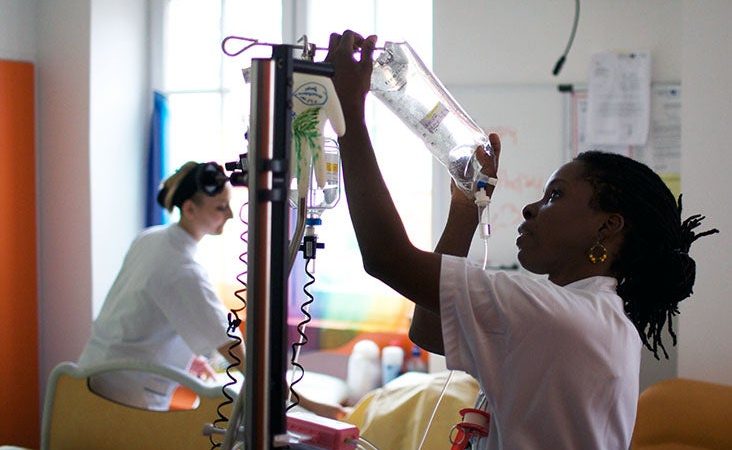
- About 19 million people globally have cancer, for which many will receive chemotherapy as a treatment.
- Chemotherapy does not always work for every type of cancer or person.
- Researchers from the Garvan Institute of Medical Research found a tumor’s ability to respond to chemotherapy is driven by randomness.
- Scientists identified certain drugs that can help make chemotherapy more effective when used together.
About 19 million people around the world had cancer in 2020.
Many of those people received chemotherapy as a treatment for their cancer.
However, chemotherapy does not always work for every type of cancer or every person.
Researchers at the Garvan Institute of Medical Research in Australia are reporting that a tumor‘s ability to respond to chemotherapy is driven by randomness.
Additionally, the scientists say they found combining chemotherapy with certain drugs could help chemotherapy be more effective against cancer cells that may eventually become resistant.
Their study was recently published in the journal Science Advances.
Why would chemotherapy not work?
Chemotherapy uses drugs to target the growth of rapidly dividing cells, such as cancer cells. It can destroy cancer cells and stop them from making additional cells.
Some people may only receive chemotherapy, while others may receive chemotherapy in addition to other treatments such as radiotherapy and surgery.
There are a number of factors that may impact how successful a person’s chemotherapy treatment is. These include:
- where the tumor is located
- the type of cancer
- the stage of the cancer
- the person’s age and overall health
Additionally, sometimes a tumor may be resistant to chemotherapy. Either the tumor was already resistant before treatment began or the tumor undergoes molecular changes and develops resistance.
“Many hard-to-treat cancers become resistant to chemotherapy, sometimes even within a few weeks of starting treatment,” explained Dr. Santosh Kesari, a neuro-oncologist and director of neuro-oncology at Providence Saint John’s Health Center and chair of the Department of Translational Neurosciences and Neurotherapeutics at Saint John’s Cancer Institute in California as well as regional medical director for the Research Clinical Institute of Providence Southern California.
“And sometimes in the setting of mixed responses, meaning some of the lesions improve (and) some don’t,” he told Medical News Today.
“There is a difference in some of the tumor cells and how sensitive or resistant they are to a particular drug, which is called heterogeneity, and that exists in all tumors,” Kesari added. “A tumor is not homogeneous. There are cells within that are different genetically and expression of certain genes that make it sensitive or resistant to a certain drug.”
Determining tumor cells’ resistance
According to Dr. David Croucher, an associate professor and head of the Network Biology Lab at the Garvan Institute of Medical Research and senior author of this study, researchers focused on how tumor cells from neuroblastoma — a type of cancer normally seen in children — respond to chemotherapy.
“For many cancer types, including neuroblastoma, chemotherapy remains the backbone of treatment,” he explained to Medical News Today. “However, resistance to chemotherapy is unfortunately very common. We need to understand why this resistance occurs so that we can change how chemotherapy is used and improve outcomes for these very young patients.”
In this study, researchers found neuroblastoma tumor cells can move between states of responding or not responding to chemotherapy through innate randomness.
“It’s well known that the cells within tumors can be highly heterogeneous,” Croucher said. “However, it’s often thought that this comes down to hard-wired differences in identity, often with a genetic or epigenetic basis, that control these divergent behaviors. In our study, we were surprised to find that there was a randomness to chemotherapy response, although even further intrigued to discover that this random state then becomes locked in after a tumor has relapsed.”
This randomness is caused by “noise” during the process of cancer cells dying with chemotherapy treatment.
“This type of ‘noise’ comes from the way that our cells turn the genes encoded into our DNA into proteins,” Croucher detailed. “This process relies on essentially random interactions between DNA and the molecular machinery that reads the DNA sequence and produces proteins. Because of the random timing and duration of these interactions, even tumor cells that are genetically identical can have very different levels of the same proteins. In this case, we showed that noise in the proteins that control chemotherapy response resulted in a small population of resistant tumor cells.”
Finding effective treatments
Croucher and his team reported once a cell becomes resistant to chemotherapy, it stays that way, suggesting there is a small window where treatment could be most effective.
Additionally, the researchers identified specific drugs that can help chemotherapy get past the “noise” created within tumor cells to be more effective before the cells lock into resistance.
“We found that pre-treating, or priming, neuroblastoma tumors with a certain class of drug, called an HDAC inhibitor, could restore drug sensitivity to otherwise resistant cells,” Croucher said. “In the future, these drugs could be given to patients before they receive their existing standard-of-care chemotherapy, greatly improving the ability of the tumor to respond to these treatments.”
Kesari added that this study highlights the fact that doctors need to do more combination therapies by understanding what makes a tumor cell resistant to our current chemotherapy regimens.
“There are drugs that are available that are mentioned in the publication, such as the HDAC inhibitor, or develop new drugs as we understand how this resistance works so that we can actually improve the response rate with our standard approaches,” he said. “(The study authors have) identified some important targets. And then they should validate it in larger studies preclinically. I think already a proof-of-concept study can be done in humans because there are HDAC inhibitors available on the market and in development.”
Source: Read Full Article
